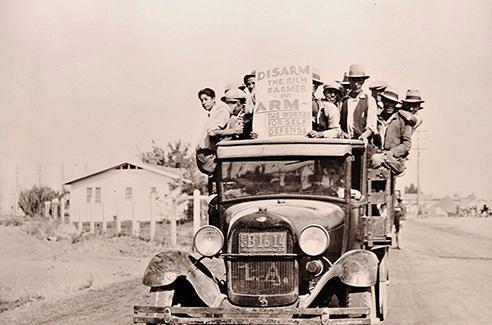
July 29, 2011 - December 4, 2011
and January 14 - February 5, 2012
The Stock Market Crash in 1929, which triggered the Great Depression, was followed by bank runs, massive unemployment, farm foreclosures, and a severe drought that led to the Dust Bowl in the Midwest. The cities and the countryside were full of poor people. In 1929, unemployment stood at 3%, and by 1933 it had risen to 25%. Fascism was on the rise in Europe and right-wing forces were making gains in the U.S. When Franklin Delano Roosevelt became president in 1933, his administration drew on the energy and activism of countless people in an effort to rebuild the collapsed economy and envision a democratic cultural sphere. In the process, FDR ushered in a new and dynamic relationship between artists and the government that lasted until the early years of World War II.
The New Deal programs of the 1930s envisioned a more inclusive society, and artists were a part of that vision. There were not only given jobs, they were enlisted to promote this ideal. The artists hired by the New Deal programs were often poor and saw themselves reflected in the images they made and in the society they helped to build.
Much of the art of the New Deal era did not reflect the economics or the politics of the times directly. In many cases, the ability of the artists just to keep working was enough. But in three areas of artistic expression reflected in this exhibition, artists created work that directly comments on the struggles and hopes of the people. This expression is represented most vividly through the photography of the Farm Security Administration (FSA), the graphics of printmaking (both inside and outside of the Works Progress Administration (WPA) Federal Arts Project), and the mural works created as a program of the U.S. Treasury Department.
The administration of Franklin Delano Roosevelt viewed art as a valuable tool to build both support for its programs and a democratic culture. FDR famously said that the art of his administration would be remembered long after the political policies were forgotten. Indeed, the art of the 1930s that spoke to the struggles of the times also reminds us of why those policies were implemented and why they mattered. Today we are living through a new era of massive unemployment and political attacks on the foundations of democratic culture. The art of the 1930s can not only speak to us of our current struggles, but remind us that we have been here before.
One of the greatest collections of photographs ever assembled was started through the personal initiative of Roy Stryker, who worked within the Farm Security Administration. He created a division that employed photographers to document the plight of farmers and the work of the FSA. Dorothea Lange was one of 22 photographers employed by the FSA. In many ways her work continues to define our understandings of the poverty of the Great Depression. The Dust Bowl migrant families that arrived by the thousands per day in California faced poverty, hunger, and harassment by police and vigilantes. One of the strengths of Lange's photographs is their ability to communicate the nobility of people living in poverty and fear.
The Works Progress Administration was the largest employer during the Great Depression and well into World War II. There were many divisions of the WPA. The Federal Arts Project Graphics division produced thousands of prints and employed over eight hundred artists. Printmakers in the WPA and those working outside the organization produced the work that spoke to the political issues of the day. These artists also organized exhibitions, distributed their prints through affordable subscription programs, and contributed to political publications. Politically engaged graphic artists focused attention on the themes of poverty, worker solidarity, anti-fascism, and anti-lynching campaigns. Some of the most powerful prints drew parallels between Christian imagery of the crucifixion and lynching. Printmakers including Victor Arnautoff, George Biddle, Julius Bloch, Jacob Burck, Richard Correll, Pele de Lappe, Mabel Dwight, Hugo Gellert, William Gropper, Riva Helfond, Louis Lozowick, Don Rico, Harry Sternberg, and Charles Surendorf, among others created powerful prints on the pressing themes of the day.
The New Deal murals that still decorate many post offices, schools, and other public buildings across the country were mostly the projects of the Treasury Department Section of Fine Arts. The politics of democratic culture in these murals is less overt than in FSA photographs of the prints of the era. Yet, due to their placement in public places, the murals are the most visible and accessible of all the art of the 1930s. They are emblematic of the democratic cultural idea, and their subjects are often historical and idealized. Many of these murals have become points of pride and identity for communities. Stephen Mopope, A Kiowa Apache artist, painted the post office in Anadarko, Oklahoma, a predominantly Native American town. It was a significant accomplishment in the 1930s that a Native American community could present themselves on a government building. A watercolor study for his mural is on display in the exhibition. Studies and photographs for several murals point to the cultural and historical background that deepens the sense of place. Works by Anton Refregier, Herman Volz, Lucienne Bloch, and others give a sense of the vision of a broadly accessible culture that seeks to unite the communities with their history.
— Art Hazelwood, Guest Curator
Image: Unknown photographer, Mexican workers on strike. California, 1933, photograph, source: Powell Studio, Corcoran, California, de Saisset Museum permanent collection, purchased from Library of Congress, Washington, D.C., NDA 6.683.
